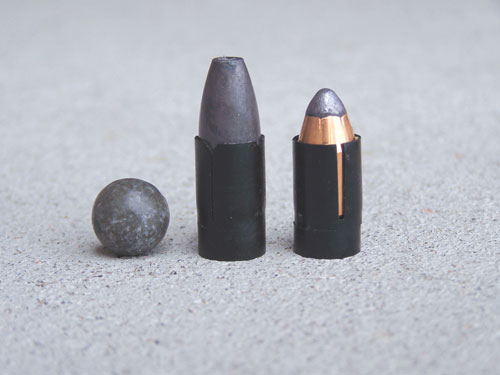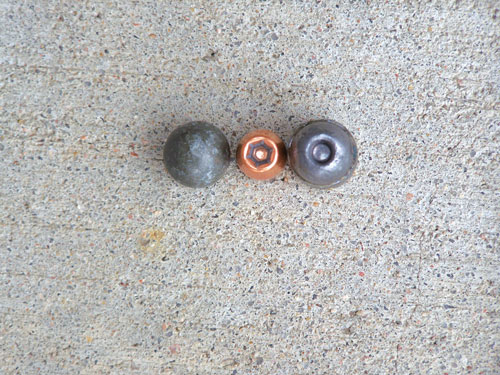 The current trend in big-game muzzleloader hunting is toward the use of sabots and 240- to 260-grain belted bullets. Advocates talk of relatively high velocities exhibited by these projectiles when used with 150-grain powder charges and associate those velocities with improved performance. The sabot has become so popular that it is sometimes difficult to locate conical bullets at many local retailers.
The current trend in big-game muzzleloader hunting is toward the use of sabots and 240- to 260-grain belted bullets. Advocates talk of relatively high velocities exhibited by these projectiles when used with 150-grain powder charges and associate those velocities with improved performance. The sabot has become so popular that it is sometimes difficult to locate conical bullets at many local retailers.
If I am going after big game with a muzzleloader, I will invariably choose a heavier conical bullet over a lightweight bullet in a sabot. In nearly 30 years of muzzleloading I have witnessed much more impressive kills and physical trauma delivered by conicals than by any smaller bullet. In fact, at most practical whitetail shooting ranges, patched round balls in .54 and .58 caliber can be excellent. When I hunt deer with a sabot projectile I prefer at least a 300-grain projectile weight. I also do not shoot any .50-caliber powder charges over 120 grains. That is because I don’t buy into the high muzzleloader velocity argument at all. I believe in the concept of the “Balanced Load.”
An effective muzzleloading rifle load is a balance of Accuracy + Knockdown Power + Rifle Management. What is the most accurate load that I can shoot from my rifle? How much contamination am I getting from fouling? Are there enough ft./lbs. of kinetic energy in that load to kill the animal efficiently? Can I comfortably manage the recoil generated by this load and will my rifle hold up under sustained shooting? A balanced load has the best accuracy possible, with minimal fouling, and will take game humanely with the most acceptable recoil. That is why I like a 400-grain conical with a 90- to 100-grain powder charge in a .50-caliber muzzleloader and a 425- to 430-grain conical with an 85-grain powder charge in a .54-caliber muzzleloader. Year in and year out, these have proven to be versatile whitetail deer loads. The performance of these big-bullet loads can be stunning.
Big-bore soft-lead conicals and round balls deliver relatively modest rifle recoil, excellent accuracy, heavy trauma, massive blood trails and bone-breaking incapacitation on whitetail deer when compared to lightweight sabot loads. At practical whitetail hunting ranges, big-bore muzzleloaders can put a buck down for keeps.
 Alas, there have not been many new conicals placed on the market in the last decade. Thompson/Center still markets the Maxi-Ball for penetration and the Maxi-Hunter for expansion. Precision Rifle markets several good conical and heavy sabot loads. Buffalo Bullets also markets a number of fine conical bullets and some outstanding heavy lead sabot loads. The most commonly sold conical is the Hornady Great Plains bullet. I honestly haven’t seen much performance difference between the brands. Some conical bullets will load quite differently in different brands of rifles. The easier it is to load a bullet, the better the accuracy potential, as long as the bullet is the proper caliber.
Alas, there have not been many new conicals placed on the market in the last decade. Thompson/Center still markets the Maxi-Ball for penetration and the Maxi-Hunter for expansion. Precision Rifle markets several good conical and heavy sabot loads. Buffalo Bullets also markets a number of fine conical bullets and some outstanding heavy lead sabot loads. The most commonly sold conical is the Hornady Great Plains bullet. I honestly haven’t seen much performance difference between the brands. Some conical bullets will load quite differently in different brands of rifles. The easier it is to load a bullet, the better the accuracy potential, as long as the bullet is the proper caliber.
Many hunters have trouble understanding why a heavy lead conical bullet is so effective on game when the velocities are relatively slow and 100-yard energy figures seem so poor. Normally a conical is fired at velocities between 1,200 and 1,600 feet per second (fps). A 370-grain .50-caliber conical with a 100-grain charge will have a velocity of about 1,450 fps. The muzzle energy of such a load is 1,727 ft./lbs., but at 100 yards, only 825 ft./lbs. My .58-caliber 260-grain round ball with a 100-grain blackpowder charge will have a velocity of around 1,300 fps. The muzzle energy of such a load is 967 ft./lbs., but at 100 yards that drops to only 455 ft./lbs. On the surface, that doesn’t look very impressive compared to a 240-grain .45-caliber pistol bullet traveling at 2,200 fps from the muzzle.
While a light bullet might have higher velocity and therefore greater muzzle energy than a conical, it will also shed that energy much faster. The momentum of the heavier conical allows it to shed its energy more slowly. That same momentum retention remains when the bullet strikes big game. A combination of bullet weight, diameter and velocity increases both penetration and trauma to an animal. Pure lead projectiles exhibit the trait of excellent molecular cohesion. Lead projectiles expand beautifully and retain nearly all of their original weight when passing through the body of a whitetail.
Many will cite the differences in velocity of smokeless-powder rifles as a means of justifying higher velocities in muzzleloading, but the most velocity that can be expected from a blackpowder rifle is about 2,300 fps using a 240-grain projectile. Blackpowder energy limits mean that if you want additional power to increase trauma to an animal, you must fall back on bullet weight and diameter to get it. A misunderstanding comes from two commonly held performance fallacies. One is that velocity alone is a measure of a bullet’s ability to deliver trauma. The problem with muzzleloaders is that 2,200 fps using a lightweight projectile is not a significant advantage over a much heavier lead projectile traveling at 1,600 fps. The second is based upon a poor understanding of relatively slow blackpowder velocities and how to make of the most of that trait. The old maxim of the bigger the hole, the more damage to the body is especially true in muzzleloading.






